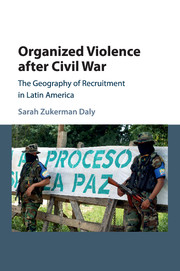Book contents
- Organized Violence after Civil War
- Reviews
- Cambridge Studies in Comparative Politics
- Organized Violence after Civil War
- Copyright page
- Dedication
- Contents
- Figures
- Tables
- Maps
- Book part
- Glossary
- 1 Introduction: A Farewell to Arms?
- 2 Theory of the Postwar Trajectories of Armed Organizations
- 3 Violence and Peace in Colombia
- 4 Geography of Recruitment and Postwar Organizational Capacity
- 5 Strategic Interactions between Armed Groups and Remilitarization
- 6 The Path to Demilitarization: Configuration of Local Militias in Antioquia
- 7 Remilitarization, Strong and Weak: Local and Non-local Militias in Catatumbo and Urabá/Córdoba
- 8 Beyond Colombia: Transitions from War to Peace in Comparative Perspective
- 9 Conclusion
- Book part
- References
- Index
- References
References
Published online by Cambridge University Press: 05 February 2016
- Organized Violence after Civil War
- Reviews
- Cambridge Studies in Comparative Politics
- Organized Violence after Civil War
- Copyright page
- Dedication
- Contents
- Figures
- Tables
- Maps
- Book part
- Glossary
- 1 Introduction: A Farewell to Arms?
- 2 Theory of the Postwar Trajectories of Armed Organizations
- 3 Violence and Peace in Colombia
- 4 Geography of Recruitment and Postwar Organizational Capacity
- 5 Strategic Interactions between Armed Groups and Remilitarization
- 6 The Path to Demilitarization: Configuration of Local Militias in Antioquia
- 7 Remilitarization, Strong and Weak: Local and Non-local Militias in Catatumbo and Urabá/Córdoba
- 8 Beyond Colombia: Transitions from War to Peace in Comparative Perspective
- 9 Conclusion
- Book part
- References
- Index
- References
- Type
- Chapter
- Information
- Organized Violence after Civil WarThe Geography of Recruitment in Latin America, pp. 279 - 298Publisher: Cambridge University PressPrint publication year: 2016



